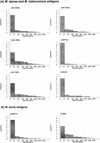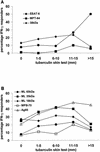Gamma interferon responses induced by a panel of recombinant and purified mycobacterial antigens in healthy, non-mycobacterium bovis BCG-vaccinated Malawian young adults
- PMID: 12853392
- PMCID: PMC164276
- DOI: 10.1128/cdli.10.4.602-611.2003
Gamma interferon responses induced by a panel of recombinant and purified mycobacterial antigens in healthy, non-mycobacterium bovis BCG-vaccinated Malawian young adults
Abstract
We have previously shown that young adults living in a rural area of northern Malawi showed greater gamma interferon (IFN-gamma) responses to purified protein derivatives (PPD) prepared from environmental mycobacteria than to PPD from Mycobacterium tuberculosis. In order to define the mycobacterial species to which individuals living in a rural African population have been exposed and sensitized, we tested T-cell recognition of recombinant and purified antigens from M. tuberculosis (38 kDa, MPT64, and ESAT-6), M. bovis (MPB70), M. bovis BCG (Ag85), and M. leprae (65 kDa, 35 kDa, and 18 kDa) in >600 non-M. bovis BCG-vaccinated young adults in the Karonga District of northern Malawi. IFN-gamma was measured by enzyme-linked immunosorbent assay (ELISA) in day 6 supernatants of diluted whole-blood cultures. The recombinant M. leprae 35-kDa and 18-kDa and purified native M. bovis BCG Ag85 antigens induced the highest percentages of responders, though both leprosy and bovine tuberculosis are now rare in this population. The M. tuberculosis antigens ESAT-6 and MPT64 and the M. bovis antigen MPB70 induced the lowest percentages of responders. One of the subjects subsequently developed extrapulmonary tuberculosis; this individual had a 15-mm-diameter reaction to the Mantoux test and responded to M. tuberculosis PPD, Ag85, MPT64, and ESAT-6 but not to any of the leprosy antigens. We conclude that in this rural African population, exposure to M. tuberculosis or M. bovis is much less frequent than exposure to environmental mycobacteria such as M. avium, which have antigens homologous to the M. leprae 35-kDa and 18-kDa antigens. M. tuberculosis ESAT-6 showed the strongest association with the size of the Mantoux skin test induration, suggesting that among the three M. tuberculosis antigens tested it provided the best indication of exposure to, or infection with, M. tuberculosis.
Figures




References
-
- Andersen, P., M. E. Munk, J. M. Pollock, and T. M. Doherty. 2000. Specific immune-based diagnosis of tuberculosis. Lancet 356:1099-1104. - PubMed
-
- Arend, S. M., P. Andersen, K. E. van Meijgaarden, R. L. Skjot, Y. W. Subronto, J. T. van Dissel, and T. H. Ottenhoff. 2000. Detection of active tuberculosis infection by T cell responses to early-secreted antigenic target 6-kDa protein and culture filtrate protein 10. J. Infect. Dis. 181:1850-1854. - PubMed
-
- Banasure, K. D., S. H. Basagoudanavar, P. Chaudhury, V. Tiwari, N. S. Parihar, and P. P. Goswami. 2001. Identification and characterization of a gene encoding a 35-kDa protein from Mycobacterium avium subspecies paratuberculosis. FEMS Microbiol. Lett. 196:195-199. - PubMed
-
- Belisle, J. T., V. D. Vissa, T. Sievert, K. Takayama, P. J. Brennan, and G. S. Besra. 1997. Role of the major antigen of Mycobacterium tuberculosis in cell wall biogenesis. Science 276:1420-1422. - PubMed
Publication types
MeSH terms
Substances
Grants and funding
LinkOut - more resources
Full Text Sources

